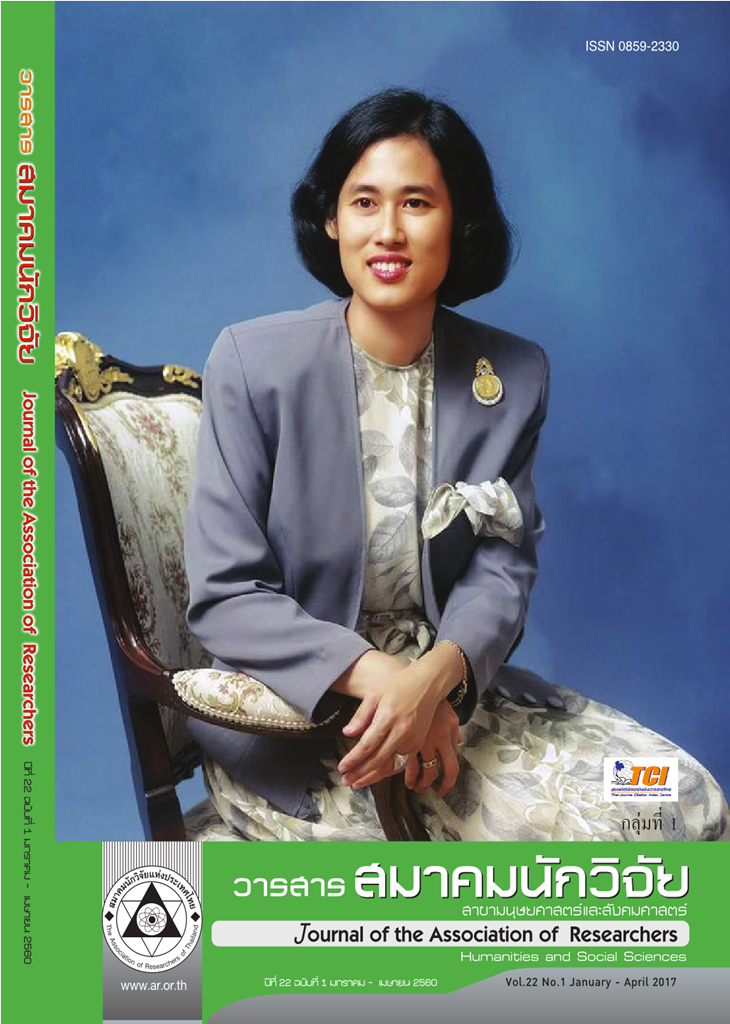Learning Organization, Organizational Climate, Organizational Citizenship Behavior and Knowledge Sharing of Subunits within Technical Department Thai Airways Public Company Limited
Main Article Content
Abstract
The main purpose of this paper was to investigate the relationships and the influences among Learning Organization, Organizational Climate, Organizational Citizenship Behavior and Knowledge Sharing of all departments and divisions within Technical Department Thai Airways Public Company Limited.
The population of this study covered all Technical Department consisting of 73 departments and 103 divisions. The respondents consisted of 707 persons from 176 units. The survey research had been used in this study. The research results indicated that there were the statistical significant positive relationships for
every pair of variables. In addition, Learning Organization, Organizational Climate and Organizational Citizenship Behavior had the statistical significant positive total effects on Knowledge Sharing. The square multiple correlation coefficient (R2) indicated that 77.00 % of the variance in Knowledge Sharing can be explained by the combination of Learning Organization, Organizational Climate and Organizational Citizenship Behavior.
Article Details
บทความที่ปรากฏในวารสารนี้ เป็นความรับผิดชอบของผู้เขียน ซึ่งสมาคมนักวิจัยไม่จำเป็นต้องเห็นด้วยเสมอไป การนำเสนอผลงานวิจัยและบทความในวารสารนี้ไปเผยแพร่สามารถกระทำได้ โดยระบุแหล่งอ้างอิงจาก "วารสารสมาคมนักวิจัย"
References
พงษ์เทพ จันทรสุวรรณ. (2554). ภาวะผู้นำ วัฒนธรรมองค์การกับประสิทธิผลองค์การของโรงเรียนในสังกัดกรุงเทพมหานคร :ตัวแบบสมการโครงสร้าง วิทยานิพนธ์ปริญญาปรัชญาดุษฎีบัณฑิต, คณะพัฒนาสังคมและการจัดการสิ่งแวดล้อมสถาบันบัณฑิตพัฒนบริหารศาสตร์.
สฎายุ ธีระวณิชตระกูล. (2549). แบบจำลองความสัมพันธ์เชิงสาเหตุของพฤติกรรมการเป็นสมาชิกที่ดีต่อองค์การของอาจารย์คณะศึกษาศาสตร์ในมหาวิทยาลัยของรัฐ วารสารวิจัยและวัดผลการศึกษา ปีที่ 4 ฉบับที่ 1 มีนาคม 2549.
References
Ajzen.I., and Fishbein, M.(1980). Understanding Attitude and Predicting Social Behavior. Englewood Cliffs, NJ : Prentice Hall.
Aliei, M., Ashrafi, B. and Aghayan, S. (2011). Studying the Relationship between Organizational Citizenship Behavior and Knowledge Sharing. Journal of Contemporary Research in Business. 3, 3 (July): 341-348.
Azizi Yahaya1, Yusof Boon1, Jamaludin Ramli1, Noor Aina Baharudin Noordin Yahaya, Jasmi Ismail &Zainudin Shariff .(2011). The implications of Organizational Citizenship Behavior.
(OCB) towards the dimensions of Learning Organization (LO) in organizations in Southern Malaysia. AfricanJournal of Business Management Vol. 5(14), pp. 5724-5737.
Ba, S., Stallaert, J., Whinston, A.B. (2001). Research commentary: Introducing a third dimension information systems design – The case for incentive alignment. Information Systems Research. 12(3): 225–239.
Bock, G.-W., Zmud, R.W., Kim, Y.-G., Lee, J.-N. (2005). Behavioral intention formulation in knowledge sharing: Examining the roles of extrinsic motivators, social–psychological forces, and organizational climate. MIS Quarterly. 29(1): 87–111.
Chandasuwan, Pongthep. (2011). Leadership, Organizational Culture and Organizational Effectiveness of The Schools Managed by Bangkok Metropolitan Administration: Structural Equation Modeling. Thesis Doctor of Philosophy, Faculty of Social and Environmental Management. NIDA. (in Thai).
Chiang.C.C. (2002). A study on the relationships among organization climate,organizational commitmentand organization citizenship behavior-taking the C factory as example. Retrieved August 28,2009,from http://ctd.lib.nsysu.cdu.tw/ETD-db/ETD-search/view.
Cohen,A.&Keren,D. (2009). Does climate matter? An examination of relationship between organizationl Climate and OCB among Israeli teachers. [Electronic version]. The Service Industries Journal,1,1-17.
Davenport, T.H., Prusak, L. (1998). Working Knowledge: How Organizations Manage What They Know.Harvard Business School Press,Boston, MA.
Gavin, D. A. (1993). Building a Learning Organization. Harvard Business Review. (July-August):78-91.
Hooff, B.V., and Ridder, J.A. (2004). Knowledge Sharing in Context: The Influence of Organizational Commitment, Communication Climate and CMC Use on Knowledge Sharing. Journal of Knowledge Management. 8 (6): 117-130.
Jacobs, E. & Roodt,G. (2007). The development of a knowledge sharing construct to predict turnover intentions. Aslib Proceedings, 59(3), 229-248.
Jen-te Yang. (2007). The impact of knowledge sharing on organizational learning and effectiveness. Journal of Knowledge Management. Vol. 11 Iss: 2. 83 – 90.
Katz , D., & Kahn, R.L. (1978). The Social Psychology of Organizations. Wiley. New York,Kristin I.T. Skinnarland, Itera ASA, Oslo, and Dr. Peter Sharp,
Knowledge Sharing (KS).(2013). Organizational Learning and Competitive Advantage in a Scandinavian Hotel Company. Regent’s College,London.
Leila Canaan Messarra, Abdul-Nasser El-Kassar. (2013). Identflying Organization Climate Affecting Learning Organization. Lebanese American UniversityBeirut, Lebanon.
Liebowitz, J. (2001). Knowledge Management and its Link to Artificial Intelligence. Expert System with Applications. 20: 1-6.
Lin, C. P. (2008). Clarifying the Relationship Between Organizational Citizenship Behaviors, Gender and Knowledge Sharing in Workplace Organization in Taiwan. Journal of Business and Psychology. 22,3 (March): 241-250.
Marsick, V. J., and Watkins, K. E. (2003). Demonstrating the Value of an Organization’s Learning Culture:the Dimensions of the Learning Organization Questionnaire. Advances in Developing Human Resources. 5 (May): 132-151.
Nasiri, Mardan Pour. (2014). A Perspective on Behavioral Intention Formation Model in KnowledgeSharing. Asian Journal of Research in Business Economics & Management; Vol. 4 Issue 6, preceding.418.
Polanyi, M. (1997). The tacit dimension, L. Prusak, Editor, Knowledge in organisations. ButterworthHeinemann. Boston. 135–146.
Philip M. Podsakoff, Scott B. MacKenzie, Julie Beth Paine, and Daniel G. Bachrach. (2000). Organizational citizenship behaviors: A critical review of the the oretical and empirical iterature and suggestions for future research. Journal of Management. 26 (3): 513-563.
Senge, P. M. (1990). The fifth disciplines: the art and practice of learning organization. London : CenturyBusiness.
Stringer, R. (2002). Leadership and Organization Climate. New Jersey: Person Education. Inc. Steers, R.M., & Porter, L.W.1979. Motivation and work behavior. New York: Mcgraw-Hill.Talat Islam, Farooq Anwar, Saif Ur Rehman Khan, Amran Rasli, Ungku Norulkamar BT Ungku Ahmad and
Ishfaq Ahmed. (2012). Investigating the Mediating Role of Organizational Citizenship BehaviorBetween Organizational Learning Culture and Knowledge Sharing. World Applied Sciences Journal 19 (6): 795-799.
Teeravanittakul, Sadayu. (2006). A Causal relationship model of organizational citizenship behavior of
educational faculties in public universities. Journal of Educational Research and Measurement, Volume 4, Number 1 March 2006. (in Thai).
Thepphawan, Phichit. (2005). Dimensions of Organizational Climate Toward Developing Learning Organization : Best Practices of North – Chiang Mai University. Faculty of Business Administration North – Chiang Mai University. (in Thai).
Zack, M.H. (1999). Managing codified knowledge. Sloan Management Review .40(4): 45–58.


